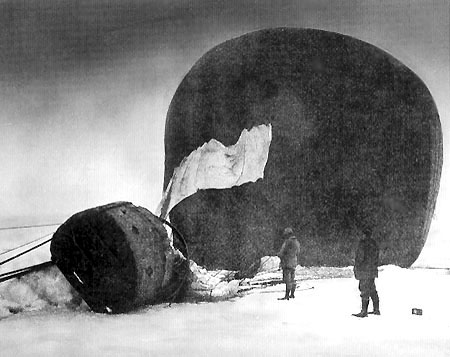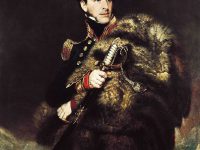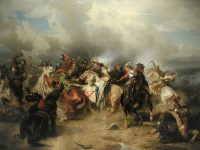
Örnen (The Eagle) along with Salomon Andrée and Knut Frænkel shortly after its descent onto pack ice. Photographed by Nils Strindberg.
On July 13, 1897, the balloon of S. A. Andrée’s Arctic Balloon Expeditions crashed on the pack ice. S. A. Andrée, the first Swedish balloonist, proposed a voyage by hydrogen balloon from Svalbard, Sweden to either Russia or Canada, which was to pass, with luck, straight over the North Pole on the way. Unfortunately, Andrée did not succeed, disregarding the forces of nature in the series of events that led to his death and those of his two companions Nils Strindberg and Knut Frænkel.
Salomon August Andrée – Early Years
Salomon August Andrée was born in the small town of Gränna, Sweden. He attended the Royal Institute of Technology in Stockholm and graduated with a degree in mechanical engineering in 1874. Andrée went to a Centennial Exposition in Philadelphia, where he was employed as a janitor. During his trip to the United States, Andrée met balloonist John Wise which initiated his fascination with balloon travel. After returning to Sweden, Andrée held various employments including a position at the Royal Institute of Technology and his participation in Swedish scientific expedition to Spitsbergen led by Nils Ekholm, where he was responsible for the observations regarding air electricity.
Across the Arctic Sea in a Balloon
Salomon August Andrée proposed a plan for letting the wind propel a hydrogen balloon from Svalbard across the Arctic Sea to the Bering Strait, to fetch up in Alaska, Canada, or Russia, and passing near or even right over the North Pole on the way. He proceeded to buy his own balloon in 1893 and completed nine journeys with it, starting from Gothenburg or Stockholm. Andrée kept trying out various techniques for his projected North Pole expedition. For his exploration ideas, Andrée found it quite easy to gain support. For instance, he was able to initiate the enthusiasm of geographers and meteorologists at a lecture in 1895 to the Royal Swedish Academy of Sciences. He assured the audience that Arctic summer weather was uniquely suitable for ballooning and managed to find support by King Oscar II and Alfred Nobel.
A Problem with the Seal
For his 1896 expedition to launch the balloon, Salomon August Andrée had many volunteers to choose from and picked the experienced Arctic meteorological researcher Nils Gustaf Ekholm and the student Nils Strindberg. The expedition’s objective was to map the area by means of aerial photography, and Strindberg was both a devoted amateur photographer and a skilled constructor of advanced cameras. Even though the team was very experienced in concerns of technology and science, they lacked physical skills to survive under extreme conditions. They faced more obstacles when the launch was close. Despite Andrée’s optimism on the weather conditions, the wind kept blowing steadily from the north, straight at the balloon hangar at Danskøya, until the expedition had to pack up. Also, the balloon failed to retain hydrogen with a leakage coming from the approximately eight million tiny stitching holes along the seams, which no amount of glued-on strips of silk or applications of special secret-formula varnish seemed to seal. Therefore, the balloon was losing 68 kilograms of lift force a day which would have reduced the expedition’s ability to stay airborne from 30 to possibly 17 days at most. It is believed that Nils Ekholm warned Andrée that he would not take part in the next attempt, scheduled for summer 1897, unless a stronger, better-sealed balloon was organized.
The Expedition
In the summer of 1897, the expedition returned to Danskøya and found that the winds were more favorable and Ekholm was replaced by Knut Frænkel. On July 11, the explorers climbed into the basket and rose into the air slowly. Aboard the balloon there were two ways of communicating with the outside world, buoys and homing pigeons. Already during the take off, there were many problems. The balloon moved out low over the water and was pulled so far down by the friction of the several-hundred-meter-long drag ropes against the ground as to dip the basket into the water. The roped were twisted and detached from their screw holds. As one of them unscrewed 530 kg of rope were suddenly lost and the explorers proceeded to dump more than 200 kg of sand from the balloon to get the basket clear of the water. So already after a few minutes, a large amount of essential weight was lost which caused the balloon to rise to 700 m where the lower air pressure made the hydrogen escape all the faster through the eight million little holes. The balloon’s free flight lasted for about 10 hours and was followed by another 41 hours of bumpy ride with frequent ground contact before the inevitable final crash. Andrée noted in his diary that none of the three men got any sleep during their travel time.
The Crash
Strindberg managed to take about 200 photos with his seven-kilogram camera over the course of the three months they spent on the pack ice, one of the most famous being his picture of Andrée and Frænkel contemplating the fallen Eagle. Andrée and Frænkel also kept records of their experiences and geographical positions in their diaries while Strindberg’s own stenographic diary was more personal in content, and included his general reflections on the expedition. It seems that the men’s equipment was not put together carefully. Their clothes included no furs but were woollen coats and trousers, plus oilskins. However, the explorers reported always seeming to be damp or wet from the half-frozen pools of water on the ice and the typically foggy, humid Arctic summer air, and preoccupied with drying their clothes, mainly by wearing them.
All Dead
After about a week, the explorers left the crash site, taking as much food with them as possible. However, after only one week they sorted out and left behind a big pile of food and non-essential equipment, bringing the loads down to 130 kg per sled. It became more necessary than ever to hunt for food. They shot and ate seals, walruses, and especially polar bears throughout the march. On their way to Franz Josef Land, the men soon realized that their struggle across the ice was hardly bringing the goal any nearer as the drift of the ice was in the opposite direction and moving them backwards. They then decided to aim for Sjuøyane in the southwest instead, but the terrain to get there was also extremely difficult. In September, the explorers resigned themselves to wintering on the ice and camped on a large floe, letting the ice take them where it would. However, more bad luck was to come. After building a winter housing against the increasing cold, the floe began to break up directly under the hut from the stresses of pressing against Kvitøya, and they were forced to bring their stores on to the island itself, which took a couple of days. It is inferred from the incoherent and badly damaged last pages of Andrée’s diary that the three men were all dead within a few days of moving onto the island.
Finding the Remains
The Norwegian Bratvaag Expedition found the remains of the S.A. Andrée Expedition on August 5, 1930. Next to other things, the expedition uncovered a journal and two skeletons, identified as Andrée’s and Strindberg’s remains by monograms found on their clothing. Frænkel’s body was found later as well among Strindberg’s photographic film, his logbook and maps. After being returned to Sweden, the bodies were cremated in 1930 without further examination. A lot of theories evolved considering the three men’s causes of death. To the best-known suggestions belongs the theory by the medical practitioner Ernst Tryde. He believed that the men succumbed to trichinosis, which they had contracted from eating undercooked polar bear meat. Other suggestions have included vitamin A poisoning from eating polar bear liver. Lead poisoning from the cans in which their food was stored is an alternative suggestion, as are scurvy, botulism, suicide, and polar bear attack.
Andrée’s 1897 Arctic Balloon Expedition, [6]
References and Further Reading:
- [1] Andrée and the Aeronaut’s Voyage to the Top of the World by Alan Bellows at damninteresting.com
- [2] Ice Balloon: Doomed Arctic expedition to the north pole at BBC
- [3] More articles about Arctic Expeditions at SciHi blog
- [4] Knut Fraenkel at Wikidata
- [5] Salomon August Andrée at Wikidata
- [6] Andrée’s 1897 Arctic Balloon Expedition, The oho! Signal @ youtube
- [7] “Lesson Learned: Don’t Fly To North Pole In A Balloon”. NPR.org.
- [8] “The Journey: An Account of S. A. Andrée’s Arctic Expedition of 1897”. The Journey. Brian’s Escape
- [9] Works by or about Salomon August Andrée at Internet Archive
- [10] Timeline of Research Expeditions, via Wikidata





